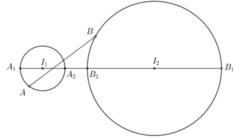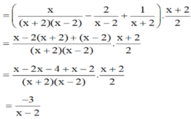cho biểu thức C=1+2+22+23+...+29 . khi đó C+1 bằng
Hãy nhập câu hỏi của bạn vào đây, nếu là tài khoản VIP, bạn sẽ được ưu tiên trả lời.


1/
Tổng A là tổng các số hạng cách đều nhau 4 đơn vị.
Số số hạng: $(101-1):4+1=26$
$A=(101+1)\times 26:2=1326$
2/
$B=(1+2+2^2)+(2^3+2^4+2^5)+(2^6+2^7+2^8)+(2^9+2^{10}+2^{11})$
$=(1+2+2^2)+2^3(1+2+2^2)+2^6(1+2+2^2)+2^9(1+2+2^2)$
$=(1+2+2^2)(1+2^3+2^6+2^9)$
$=7(1+2^3+2^6+2^9)\vdots 7$

Chọn C
Gọi A (d; e; f) thì A thuộc mặt cầu (S1): (x - 1)2 + (y - 2)2 + (z- 3)2 = 1 có tâm I1 = (1; 2; 3), bán kính R1 = 1
B (a; b; c) thì B thuộc mặt cầu (S2): (x - 3)2 + (y - 2)2 + z2 = 9 có tâm I2 = (-3; 2; 0), bán kính R2 = 3
Ta có I1I2 = 5 > R1 + R2 => (S1) và (S2) không cắt nhau và ở ngoài nhau.

Dễ thấy F = AB, AB max khi A ≡ A1; B ≡ B1
=> Giá trị lớn nhất bằng I1I2 + R1 + R2 = 9.
AB min khi A ≡ A2; B ≡ B2
=> Giá trị nhỏ nhất bằng I1I2 - R1 - R2 = 1.
Vậy M - m =8

\(A=\dfrac{1+2+3+...+9}{21+22+...+29}\)
\(=\dfrac{\left(1+9\right)+\left(2+8\right)+\left(3+7\right)+...+\left(5+5\right)}{\left(21+29\right)+\left(22+28\right)+\left(23+27\right)+...+\left(25+25\right)}\)
\(=\dfrac{10+10+10+...+10}{50+50+50+...+50}\)
\(=\dfrac{10\times5}{50\times5}\)
\(=\dfrac{10}{50}\)
\(=\dfrac{1}{5}\)
| #Sahara |

a) \(A=2+2^2+2^3+...+2^{2017}\)
\(2A=2^2+2^3+2^4+...+2^{2018}\)
\(2A-A=\left(2^2+2^3+2^4+...+2^{2018}\right)-\left(2+2^2+2^3+...+2^{2017}\right)\)
\(A=2^{2018}-2\)
b) \(C=1+3^2+3^4+...+3^{2018}\)
\(3^2\cdot C=3^2+3^4+3^6+...+3^{2020}\)
\(9C-C=\left(3^2+3^4+3^6+...+3^{2020}\right)-\left(1+3^2+3^4+...+3^{2018}\right)\)
\(8C=3^{2020}-1\)
\(\Rightarrow C=\dfrac{3^{2020}-1}{8}\)
\(Toru\)

a) Đặt: \(A=1+2^2+2^3+...+2^{10}\)
\(\Rightarrow2A=2\left(1+2^2+2^3+...+2^9+2^{10}\right)\)
\(\Rightarrow2A=2+2^3+2^4+...+2^{10}+2^{11}\)
\(\Rightarrow2A-A=\left(2+2^3+2^4+...+2^{10}+2^{11}\right)-\left(1+2^2+2^3+...+2^{10}\right)\)
\(\Rightarrow A=\left(2^3-2^3\right)+\left(2^4-2^4\right)+...+\left(2-1\right)+\left(2^{11}-2^2\right)\)
\(\Rightarrow A=0+0+...+1+\left(2^{11}-2^2\right)\)
\(\Rightarrow A=1+2^{11}-2^2=1+2048-4=2045\)
Vậy: \(1+2^2+2^3+...+2^{10}=2045\)
b)
a] \(60-3\left(x-1\right)=2^3\cdot3\)
\(\Rightarrow60-3\left(x-1\right)=24\)
\(\Rightarrow3\left(x-1\right)=36\)
\(\Rightarrow x-1=12\)
\(\Rightarrow x=13\)
b] \(\left(3x-2\right)^3=2\cdot2^5\)
\(\Rightarrow\left(3x-2\right)^3=2^6\)
\(\Rightarrow\left(3x-2\right)^3=\left(2^2\right)^3\)
\(\Rightarrow3x-2=2^2\)
\(\Rightarrow3x=6\)
\(x=2\)
c] \(5^{x+1}-5^x=500\)
\(\Rightarrow5^x\left(5-1\right)=500\)
\(\Rightarrow5^x\cdot4=500\)
\(\Rightarrow5^x=125\)
\(\Rightarrow5^x=5^3\)
\(\Rightarrow x=3\)
d] \(x^2=x^4\)
\(\Rightarrow x=x^2\)
\(\Rightarrow x-x^2=0\)
\(\Rightarrow x\left(1-x\right)=0\)
\(\Rightarrow\left[{}\begin{matrix}x=0\\1-x=0\end{matrix}\right.\)
\(\Rightarrow\left[{}\begin{matrix}x=0\\x=1\end{matrix}\right.\)

ta có :
1/2=1/40+1/40+....+1/40 (20 số hạng)
1/21+1/22+1/23....+1/40(có 20 số hạng)
vì 1/21>1/40
1/22>1/40
..........
1/39>1/40
1/40=1/40
=>A<1/2
A<1 chịu
Ta có
\(\frac{1}{40}< \frac{1}{21}\\ \frac{1}{40}< \frac{1}{22}\\ ...\\ \frac{1}{40}< \frac{1}{39}\)
Mà số phần từ của A là 20
\(\Rightarrow\frac{1}{40}.20< A\Leftrightarrow\frac{1}{2}< A\)
Còn chứng minh bé hơn 1 thì tương tự bạn nhé!



\(C=1+2+2^2+...+2^9\)
=>\(2C=2+2^2+2^3+...+2^{10}\)
=>\(2C-C=2+2^2+...+2^{10}-1-2-...-2^9\)
=>\(C=2^{10}-1\)
=>\(C+1=2^{10}\)
\(C=1+2+2^2+2^3+...+2^9\\ 2C=2+2^2+2^3+...+2^{10}\\ 2C-C=C=\left(2+2^2+2^3+...+2^{10}\right)-\left(1+2+2^2+2^3+...+2^9\right)\\ C=2^{10}-1\)
Khi đó
\(C+1=2^{10}-1+1\\ C+1=2^{10}\)